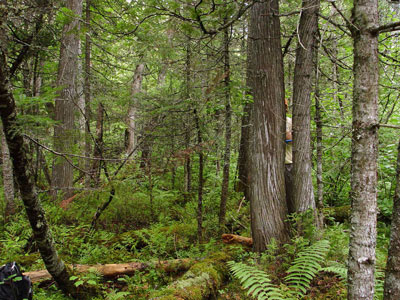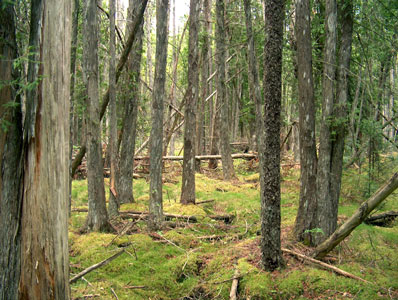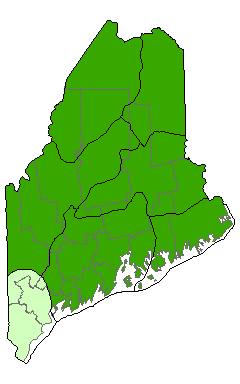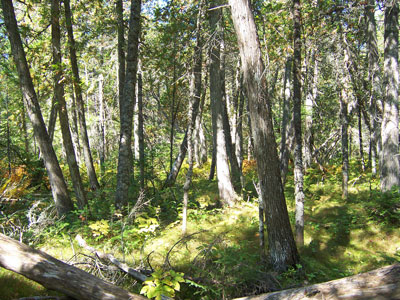DACF Home → Bureaus & Programs → Maine Natural Areas Program → Communities, Plants, and Animals → Natural Community Fact Sheets→Northern White Cedar Swamp
Printer Friendly Fact Sheet - 780 KB pdf (Get a free copy of Adobe Acrobat Reader)
Northern White Cedar Swamp
Scientific Name: Northern White Cedar Swamp; State Rank: S4

- Community Description
- Soil and Site Characteristics
- Diagnostics
- Similar Types
- Conservation, Wildlife and Management Considerations
- Distribution
- Characteristic Plants
- Associated Rare Plants
- Associated Rare Animals
- Examples on Conservation Lands You Can Visit
Community Description: This type is moderately to densely forested, often with little light penetrating to the forest floor. Northern white cedar is dominant (up to 95% cover), often forming a fairly uniform stand, but may be interspersed with various amounts of red maple (up to 25% cover ), black spruce (up to 40% cover), or, less frequently, larch, yellow birch or balsam fir. The variable shrub and ground layers form a lush mosaic of vegetated hummocks interspersed with moist hollows; alder may be frequent. The herb layer is well developed (>30% cover), with herbs more abundant than dwarf shrubs. Small cedar trees and an array of boreal herbs grow on the fallen logs and hummocks, including yellow lady’s-slipper and several rare species. Sphagnum and other mosses blanket the hummocks, hollows, and fallen logs. Back to top.
Soil and Site Characteristics: This community typically occupies level, poorly drained basins along stream flowages or the perimeter of ponds. The substrate is usually shallow peat (< 50 cm) over mineral soil; some sites are on deep peat accumulations. The characteristically alkaline conditions in this community type provide suitable habitat for a number of rare plant species. Back to top.

Diagnostics: Sites are basin wetlands with >60% tree canopy cover and northern white cedar as the dominant tree. Peat mosses are the dominant bryophytes. The substrate is organic peat or muck. Back to top.
Similar Types: Evergreen Seepage Forests are underlain by mineral soils, sometimes with a thin peat layer, and tend to occur on gentle slopes. They also have different mosses; feather-mosses (especially mountain-fern moss) and three-lobed bazzania will generally exceed peat mosses in total cover. Open Cedar Fens are partially forested peatlands with a patchy canopy of northern white cedar and a substantial cover of heath or other dwarf shrubs (usually >15% cover); open peatland vegetation types will usually occur with this type as part of the peatland. However, these three cedar types may grade into one another as part of large drainage basins. Back to top.
Conservation, Wildlife and Management Considerations: Most examples of northern white cedar swamps have been logged at least once in the past. Cedar swamps in northern Maine can be very extensive, running into hundreds of acres, and therefore it is more problematic to maintain examples not subject to human disturbance. In southern Maine, they are often less than 50 acres in size. Although the overall extent of this community type appears stable, there are some indications that it is difficult to regenerate cedar rather than fir through harvest practices. There has been little permanent conversion to other land uses or forest types. Some sites have been significantly altered by beaver activity.
This community type may be used as nesting habitat by a number of coniferous forest specialist bird species, including black-backed woodpecker, palm warbler, yellow-bellied flycatcher, gray jay, boreal chickadee, Swainson's thrush, and northern waterthrush. Northern white cedar swamps that have a large number of dead trees provide ideal habitat for the three-toed woodpecker. Back to top.
Distribution: Throughout the New England - Adirondack Province and Laurentian Mixed Forest Province, but most extensive in northern Maine. Extends north, west, and east from Maine. Landscape Pattern: Large Patch (although in more southerly locations in the state, swamps are often small, < 50 acres). Back to top.


Characteristic Plants: These plants are frequently found in this community type. Those with an asterisk are often diagnostic of this community.
- Canopy
- Black spruce
- Northern white cedar*
- Red spruce
- Tamarack
- White spruce
- Sapling/shrub
- Black spruce*
- Northern white cedar*
- Red spruce
- Speckled alder
- Winterberry
- Herb
- Balsam fir*
- Creeping snowberry
- Northern white cedar*
- Red spruce
- Three-seeded sedge*
- Bryoid
- Mountain fern moss
- Sphagnum girgensohnii*
- Other peat mosses
- Bog bedstraw
- Hoary willow
- Lapland buttercup
- Livid sedge
- Northern bog sedge
- Showy lady's-slipper
- Small round-leaved orchis
- Sparse-flowered sedge
- White adder's-mouth
There are no documented rare animals associated with this natural community.
Examples on Conservation Lands You Can Visit
| Example | County |
|---|---|
| Deboullie Ponds Public Lands | Aroostook Co. |
| Gott Brook, Dwinal Flowage Wildlife Management Area | Penobscot Co. |
| Great Heath Public Lands | Washington Co. |
| Petit Manan Point, Petit Manan National Wildlife Refuge | Washington Co. |
| Salmon Brook Lake Bog Public Lands | Aroostook Co. |
